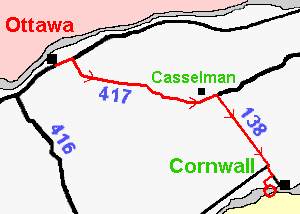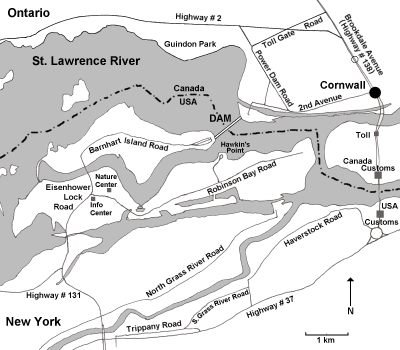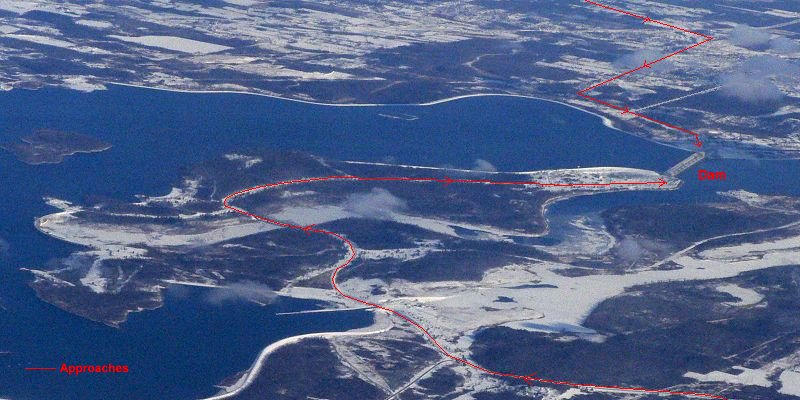Independent Directions to this Site: The Cornwall Dam, on the St. Lawrence River, is about an hour and a half ESE of Ottawa by car (about 2 hours to the US side, depending on the length of the lineup at the border). Take Highway 417 from Ottawa east 60 km to Highway 138 (exit 58 to Cornwall). Follow Hwy 138 32 km SSE to Cornwall Centre Road. Turn right or WSW on it to continue on 138, go 0.7 km to Brookdale Avenue. Turn left or SSE on it to continue on 138. Follow Brookdale (138) over Highway 401 and drive 2.3 km to Toll Gate Road.

To reach the Canadian side of the dam from Brookdale (138) and Toll Gate, turn right or southeast on Toll Gate and go 2.2 km to Power Dam Road. Turn left or SSE onto it and drive 1.0 km to Saunders Drive. Turn right or SSW onto it and proceed 0.7 km to 2nd Street West. Turn right or WNW onto it and go 0.4 km to the entrance to the Robert H. Saunders Generating Station parking area, on your left. Ask at the gatehouse for access. The best viewing is from the observation deck and adjacent parking lot. Access here is possible only during the summer (June thruogh August), and hours are variable. Because of this drawback, various alternate strategies have developed. You can bypass the gatehouse and park in the westernmost lot and climb the dyke to get a view of the headpond. Not as good, but if there's a rare bird there, who can gripe. The bypass route to view below the dam is to park outside the gatehouse and walk to the shore along the fence to its east. Further views of the headpond, a.k.a. Lake St. Lawrence, can be had from Guindon Park, just to the north. To reach it, return to Saunders Drive and turn left or NNE onto it. Go 0.4 km to Power Dam Road and turn left or NNW onto it. Proceed 1.6 km to Highway # 2 and turn left or WNW onto it. The east entrance to the park is in 0.3 km, while the western end can be accessed from Floral Drive (2.5 km from Power Dam Road) or Trillium Drive (3.3 km from Power Dam Road). The boat launch at the end of Trillium is a good spot from which to view the river. Be sure to scope the islets to the south for shorebirds during migration. Double-crested Cormorants nest there, and this is where the Great Cormorant deigned to appear.
To reach the American side of the dam from Brookdale (Highway # 138) and Toll Gate, continue straight SSE on Brookdale Avenue for 2.2 km to the traffic circle. Proceed halfway around it to continue straight on Brookdale and go 0.5 km to the split. Take the righthand lane to the international bridge and drive 1.5 km south across it to the toll booth ($2.25) on Cornwall Island. A further 1.1 km south brings you to the Canadian customs station. (* Note: Remember to have your telescopes, binoculars and cameras registered at Canadian customs before crossing the border. This eliminates any hassles re duty upon reentry.) One kilometre further south on the same road, across the bridge, brings you to the United States customs station on the American side of the St. Lawrence River. Once cleared by customs, you will go 0.4 km SSW to the traffic circle. About 0.5 km around it, take the 2nd exit to the right (for Highway 37 west/south). Follow Hwy 37 for 7.8 km WSW to Highway # 131. Turn right or NNE onto 131 and go 2.2 km to the Eisenhower Lock Road. Turn right or NNE onto it and follow it 2.4 km to the Robert Moses State Park Information Centre and the corner of Robinson Bay Road. Two routes for observation branch from here. 1. The American side of the dam, the Robert Moses Power Dam, is accessed from this junction by continuing for a further 0.7 km to the bridge to Barnhart Island and then a further 3.8 km on what has now become the Barnhart Island Road. From the parking lot at the end of this road, you can view the area below the dam; and you can go to the observation deck in the power station itself. It is open weekdays from 0900 to 1630 hrs from October to May, but until 1930 hrs June to September. Weekend access is the restricted to the tourist season: Victoria Day (late May) to Thanksgiving (Canadian style - in October). 2. For the best viewing below the dam, turn right or ESE onto Robinson Bay Road and go 3.7 km to the turnoff, on the left, for Hawkin's Point. Its parking area is 0.7 km to the north.

Site Description and Birding Information: The Cornwall Dam, a.k.a. the Moses-Saunders Power Dam, which claims to be the longest international dam in the world, can be viewed from both the Canadian and American sides of the St. Lawrence River. Because of lighting conditions, the Canadian side is best viewed in the morning and the American side in the afternoon. The best viewing is to be had from the American side, but, unfortunately, this involves the hassle of customs and extra driving. It is worth it though.
The variety of gull species found here in late fall and winter is unsurpassed in our immediate area. Altogether, 16 gull and 4 tern species have been observed here. The area below the dam, a constant churn, is the spot where most of the action is. Swirling flocks of gulls can be viewed Of course, the usual Herring, Great Black-backed and Ring-billed Gulls will be here in large numbers. Bonapatre's Gulls gather here in large numbers from August through October, often numbering in the hundreds, sometimes more than a thousand. Common Terns are seen from August to early October in numbers that sometimes reach 3 figures. They pass through in May as well. Check in September and October for the rare Arctic Tern. Once up to 20 were seen (Sep. 11, 1987) along with 400 Commons. Black Terns pass through from August to mid-September. Caspian Terns pass infrequently in early fall. Glaucous, Iceland and Thayer's Gulls can be found in small numbers in late autumn and early winter. Lesser Black-backed Gull can also be present then. Little Gulls are present in small numbers from September to early November. The rare Northern Gannet has been seen here almost yearly of late in November and December, sometimes staying a day or two (once from Nov. 22 to Dec. 3, 1986). Single Sabine's (Sah'-bin) Gulls have been seen almost yearly in September and October, though once 3 were seen. Black-legged Kittiwake is seen nearly yearly in November.
Large flocks of waterfowl congregate below the dam in late autumn and early winter. Mallard and American Black Duck are sometimes joined by Northern Pintail, Green-winged Teal and Gadwall. Thousands of Common Merganser (10,000 Dec. 9, 1990!) and hundreds of Common Goldeneye take advantage of the food stirred up by the churn. Other diving ducks present in smaller numbers this time of year are Bufflehead, Red-breasted and Hooded Merganser, Ring-necked Duck, Oldsquaw, Greater Scaup, Canvasback and Redhead (350 Nov. 3, 1990!). A few Barrow's can usually be found among the Common Goldeneye.
Above the dam, you are more likely to see loons and grebes. Common Loon, Red-necked and Horned Grebe, Brant, White-winged and Black Scoter are likely in late fall. Red-throated Loon is seen on occasion, mostly in October and November. The Murrelet and Puffin (see rarities section) were both seen here on the headpond. This also seems to be the best spot for Jaegers, with both Parasitic and Pomarine found.
The area is used migrant raptors as well, the most regular being Red-tail, Rough-legged, Red-shouldered, Cooper's and Sharp-shinned Hawks. Merlin and Pergrine Falcon are seen occasionally. Bald Eagles are more likely in winter. One or more Snowy Owls is usually present from late fall through spring.
The roads into the American side have many tangles of wild grape and crab apples, providing food and shelter for wintering American Robins (140 counted one day) and other berry lovers, such as Bohemian Waxwing, Pine Grosbeak and, once in a blue moon, a rarity such as a Varied Thrush or Sage Thrasher. This area often has Northern Shrike in winter as well. Haverstock Road, the first right off the US Customs traffic circle, though not on the direct route, is worth exploring if time permits. Follow it, then South Grass River Road and Trippany Road, back to Highway # 37. Watch for recently manured fields for Horned Larks, Snow Buntings and sometimes Lapland Longspurs. Gray Partridge are possible along these roads. Another area to explore, if you have time, is the eastern extension of Robinson Bay Road. Short-eared Owls have been seen along here at dusk. The spruces attract roosting owls and wintering finches. Northern Flickers have wintered here regularly.

Rarities seen in this locale include: Long-billed Murrelet (Oct. 11-30, 1993), Razorbill (Nov. 27, 1987), Atlantic Puffin (Oct. 14-16, 1994), Golden Eagle (Nov. 3, 1988 & Oct. 30, 1993), Ivory Gull (Dec. 8, 1977 & Jan. 13, 1978), Great Cormorant (May 2, 1991), California Gull (Oct. 24, 1990), Mew Gull (Oct. 5-6, 1986, Dec. 27, 1992, Nov. 19, 1994), Northern Fulmar (2 Dec. 15. 1994, one two days later), Franklin's Gull (Sep. 27 to Oct. 24, 1986), Pomarine Jaeger (Nov. 9, 1988 & 3 Nov. 11, 1989), Common Black-headed Gull (4 times, 3 in November), Northern Hawk Owl (Dec. 23, 1990), King Eider (Dec. 23, 1990), Gyrfalcon (Dec. 23, 1990), Harlequin Duck (Dec. 9, 1990 to Mar. 3, 1991), Parasitic Jaeger (Sep. 15, 1990), Sage Thrasher (Dec. 27, 1971), Varied Thrush (Jan. 15-17, 1991).
For further information on this site see the excellent article in the Ottawa Field-Naturalists' Club's Trail and Lanscape Vol. 29 No. 4, Oct.-Dec. 1995 titled A Birder's Guide to the Moses-Saunders Power Dam Area by Bruce & Laurie Di Labio. For up-to-the-minute access information (the rules keep changing), call Ontario Hydro at (613) 938-1518 for the Canadian side; and the New York Power Authority at (315) 764-0226 for the American side.